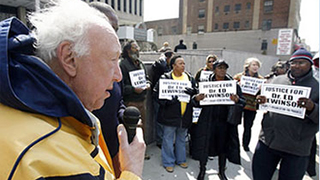About Edwin R. Lewinson

A pioneer civil rights activist, Lewinson was an early member of the Congress of Racial Equality (CORE), Brooklyn chapter. In 1949, he was arrested during a “sit-in” to desegregate the Greyhound Bus Terminal in Washington, D.C. This was not the end but the beginning of a career as a civil rights activist that spanned more than 50 years. In the summer of 1963, he was among the nearly 700 people arrested in demonstrations at the construction site of the Downstate Medical Center protesting against discriminatory hiring practices. By November of 1964, he had been arrested five times in Civil Rights demonstrations. He attended the 1963 March on Washington and the 1964 World’s Fair sit-in. He participated in the early 1960s sit-in civil rights activities to desegregate restaurants and housing and participated in marches for the passage of the 1964 Civil Rights Act and 1965 Voting Rights Act. He continued his civil rights activities with local 1199 of the Hospital Workers Union. After he retired from Seton Hall, he worked in Newark with the People Organized for Progress (POP) to advance civil rights.
Lewinson’s vision of social justice included the disabled and victims of war. He was a tireless worker for the disabled and to increase accessibility for blind people. In 1966 he was plaintiff in a lawsuit in New York State that would open jury service to blind people. In the 1980s, he served as the president of the New Jersey chapter of the National Federation of the Blind. He was an opponent of war, imperialism, colonialism, and nuclear weapons and was a member of the International Action Center and New Jersey Peace Action.
Edwin R. Lewinson passed away in 2012 at the age of 82. Throughout his life, he had an inner vision that enabled him to see people and the world in greater depth and breadth than most sighted people. That vision and commitment was based on the innate equality and humanity of all people.
Edwin Lewinson Obituary
Edwin R. Lewinson, 82, died on Tuesday at his home in South Orange, N.J. A memorial service will be held on Saturday, April 14, from 6:30 p.m. until 9:30 p.m. at the Ethical Culture Society of Essex County, 516 Prospect St., Maplewood, N.J. Ed was a peace and justice activist, professor emeritus of history at Seton Hall University and a former prisoner of conscience. Born in Detroit, Mich., he earned a Ph.D. in history from Columbia University. He taught history at Seton Hall University for over 30 years, retiring in the 1990s. He also authored two books: "John Purroy Mitchell: the Boy Mayor of New York," 1966; and "Black Politics in New York City," 1974. Over the years, he traveled to Korea, Cuba and Iraq to promote understanding between peoples. Blind from birth, Ed fought against many forms of discrimination. He worked to advance civil rights with the Congress on Racial Equality (CORE) and many other organizations. In 1949, he was arrested during a "sit-in" to desegregate the Greyhound Bus Terminal in Washington, D.C. In 2008, he served three months in federal prison for protesting a U.S. military program at Fort Benning, Ga., that was linked to human rights abuses in Latin America. Ed also worked to increase accessibility for blind people, and in 1966 was a plaintiff in a lawsuit in New York State that opened jury service to blind people. In the 1980s, he served as president of the New Jersey chapter of the National Federation of the Blind. He was active on behalf of many civic causes through local organizations, including: the New Jersey Peace Action Education Fund, Peoples Organization for Progress, South Mountain Peace Action, South Orange Lions Club, International Action Center and the School of the Americas Watch. He put into practice his belief that: "Social change only happens if people organize, unite, and take action." He showed outstanding determination in overcoming many obstacles in his life, and worked to right wrongs as he saw them in society. He faced life head-on, with a selfless, lighthearted attitude, infectious optimism and irrepressible sense of humor.

